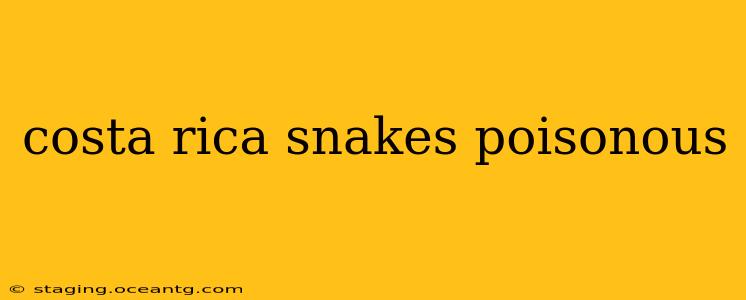Costa Rica, a land of stunning biodiversity, is also home to a variety of snakes, some of which are venomous. Understanding which snakes are poisonous (a more accurate term is venomous, as poisonous refers to substances ingested, while venomous refers to substances injected) and how to avoid them is crucial for any visitor or resident. This guide will delve into the venomous snakes of Costa Rica, explore common misconceptions, and provide valuable safety advice.
What are the most venomous snakes in Costa Rica?
Several highly venomous snakes call Costa Rica home. Among the most dangerous are:
-
Fer-de-lance ( Bothrops asper): This large, terrestrial viper is responsible for the majority of snakebites in Costa Rica. It's found throughout the country and is known for its aggressive nature and potent hemotoxic venom (which affects blood).
-
Bushmaster (Lachesis muta): The largest venomous snake in the Americas, the bushmaster is a highly venomous pit viper found in the rainforest regions. Its venom is also hemotoxic.
-
Eyelash Viper (Bothriechis schlegelii): This arboreal viper is famous for the characteristic "eyelashes" above its eyes. While smaller than the fer-de-lance and bushmaster, its venom is still highly toxic.
-
Coral Snakes (Micrurus species): Several species of coral snakes inhabit Costa Rica. They possess potent neurotoxic venom (which affects the nervous system), but are generally less aggressive and their bites are less common due to their smaller size and secretive nature. Important note: Distinguishing coral snakes from harmless mimics requires careful observation and expertise.
How common are venomous snakebites in Costa Rica?
While Costa Rica boasts a significant snake population, the number of venomous snakebites reported annually is relatively low. However, it's crucial to remember that these bites can be serious and potentially life-threatening without prompt medical attention.
What should I do if I see a snake in Costa Rica?
The best course of action when encountering a snake in Costa Rica is to leave it alone. Admire it from a safe distance, and do not attempt to handle it or provoke it in any way. Most snakes are not aggressive and will only bite if they feel threatened.
Are there any harmless snakes in Costa Rica?
Yes! Many snake species in Costa Rica are completely harmless to humans. These often include various colubrids (such as the racer snakes) and some other non-venomous species. However, it's impossible to reliably identify a snake as harmless without expert knowledge. Always err on the side of caution and treat all snakes as potentially dangerous.
How can I avoid snakebites in Costa Rica?
Prevention is key when it comes to snakebites. Here are some essential tips:
-
Wear appropriate footwear: Closed-toe shoes or boots are strongly recommended, especially when hiking in areas known for snake activity.
-
Be aware of your surroundings: Pay attention to where you place your hands and feet, especially in areas with tall grass or brush.
-
Avoid reaching into holes or crevices: Snakes often use these places for shelter.
-
Don't handle snakes: This should go without saying, but resisting the temptation to handle a snake, no matter how appealing, is crucial for your safety.
-
Use caution at night: Many snakes are more active at night.
What first aid should I administer if bitten by a venomous snake in Costa Rica?
If you are bitten by a venomous snake, immediately seek professional medical attention. While waiting for help, try to remain calm and minimize movement to slow the spread of venom. Do not attempt to suck out the venom, cut the wound, or apply a tourniquet – these actions can cause more harm than good. If possible, try to take a picture of the snake (from a safe distance) to aid identification for medical professionals.
What is the best way to identify venomous snakes in Costa Rica?
Reliable identification of venomous snakes requires expertise. While there are some general guidelines (such as the presence of triangular heads in many pit vipers), it's unwise to rely on visual identification alone to distinguish venomous from non-venomous species. If you have any doubt, treat the snake as venomous.
This guide offers a general overview of venomous snakes in Costa Rica. Remember, safety and respect for wildlife are paramount when exploring this beautiful country. Always consult with local experts or guides for detailed information and advice.
